Environment
How Social Norms Create a Culture of Censorship
Part 2: Social norms can be used to "justify" purging ideas and people.
Posted March 25, 2021 Reviewed by Devon Frye

This is the second of a three-part series on The Rise of a Culture of Censorship. The first post was on censorship by authorities, including the government.
Censorship involves shutting people up and takes two main forms:
- De-platforming: Not permitting them to use a platform to express themselves.
- Punishment: A credible threat of punishment for expressing ideas.
What is a culture of censorship? It is mostly informal processes—social, political, organizational, and psychological—that "justify" or implement suppression of the free expression of ideas. This includes the skeptical questioning or challenging of people—such as political leaders, elites, scientists, so-called "thought-leaders," and media outlets.
But it is not just the suppression of people; even more important, it is the suppression of ideas. When the expression of certain ideas has a high risk of punishment, one has a culture (or subculture) of censorship. How high is "high"? One answer is "when large numbers of people start to self-censor out of fear" (self-censorship will be the topic of my next essay).
Soviet dissident Natan Sharansky described it this way: "Can you express your individual views loudly, in public, without fear of being punished legally, formally, in any way? If yes, you live in a free society; if not, you’re in a fear society."
Informal social norms are even more important than either censorship instituted by the government or lesser authorities.
Informal But Powerful Censorious Social Norms
Greg Lukianoff, President and CEO of The Foundation for Individual Rights in Education (FIRE), a staunch defender of free expression and academic freedom, recently wrote:
"Free speech culture is more important than the First Amendment... because free speech culture is what gave us the First Amendment in the 18th century... It's what informs the First Amendment today—and it is what will decide if our current free speech protections will survive into the future."
Exhibit A
Popular idioms can reflect something of a mindset of a culture. Below, those in the left column express some aspect of free speech culture and were once common but are now less in favor. (These examples are from Lukianoff's essay linked above.)

The term "bropen science," for example, refers to the idea that certain men in the open science movement are supposedly too critical and exclusionary; the British Psych Society (BPS), for example, published an editorial saying so. They also never responded to my offer to write a reply arguing that the very notion is intended to shut down vigorous skepticism and scientific criticism. Some academics have argued that BPS has fully embraced a new culture of censoriousness (more details here).
"Punching down" is an accusation against a critic, sometimes used to deflect criticism of ideas presented publicly by lower-status people. The phrase "white women white womening" is often used to criticize White women, especially when they argue against narratives emphasizing the oppression of women; when I referred to this phrase as racist, it triggered a cancellation attack (including emails to my dean to have me punished; the attack failed because the deans at Rutgers generally do a good job of figuring out whether vile accusations are justified or, as in my case, baseless).
Exhibit B: Surveys
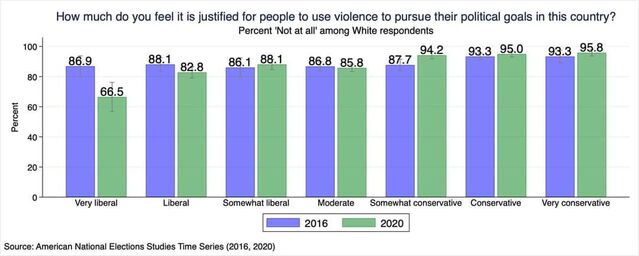
The above data are from The American National Election Studies, which is a recurring survey of representative samples of Americans, though only White respondents are included in this figure. The result on the far left ("very liberal") is striking: About one-third of those on the far left endorses some use of violence to achieve political goals. Given how Left-dominated the Academy is, this result is disturbing.
I personally suspect that people who support violence are likely to endorse all sorts of bullying and intimidation tactics. "Cancel culture" refers to a willingness to punish people for expressing the "wrong" ideas.
This figure, from political scientist Eric Kaufmann's epic report on "Academic Freedom in Crisis," shows that nearly half of all American and Canadian academics surveyed support firing colleagues for holding positions such as restricting immigration or believing that women or minorities perform worse in some contexts.
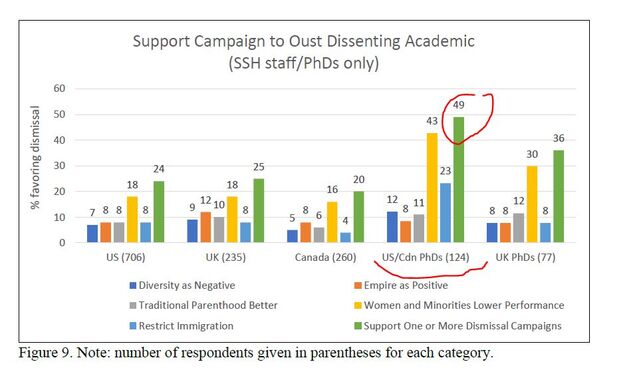
SSH refers to social sciences and humanity. The first three clusters of histograms (starting from the left) refer to "staff" which, here, means faculty. The two clusters of histograms on the right referring to PhDs are results for graduate students in PhD Programs. The results are plausibly interpretable as meaning that things are bad and likely to get worse. A quarter of U.S & U.K. faculty surveyed and nearly half of all U.S. graduate students surveyed supported at least one firing campaign. Although the grad student samples are not large, the pattern is consistent with academic intolerance that has been growing for a long time.
When political skew becomes extreme, as is the Left skew of academia, certain ideas come to seem natural and normal; anything that contests those ideas risks being seen as bizarre, extreme, and irrational. It becomes "obvious" to those in this bubble that different ideas are morally and factually wrong. Those advancing different ideas risk denunciation and ostracism, even if their ideas never actually get refuted or disconfirmed.
The flip side of this is ideas that become "sacred." Sacred ideas cannot be challenged, and anyone who attempts to do so risks being treated as a blasphemer or heretic—bullied, defamed, ostracized, and blacklisted. (For some examples, go here, here, here, here, here, here, here, or here.)
The political skew of academia is so extreme that if you were not familiar with the data, you might assume claims about it were propaganda. These data show the extreme Left skew across a range of California colleges.

These next data show that the ratio of Democrats to Republicans at each department in top universities is even more extreme, especially in the social science and humanities fields that address politicized topics.
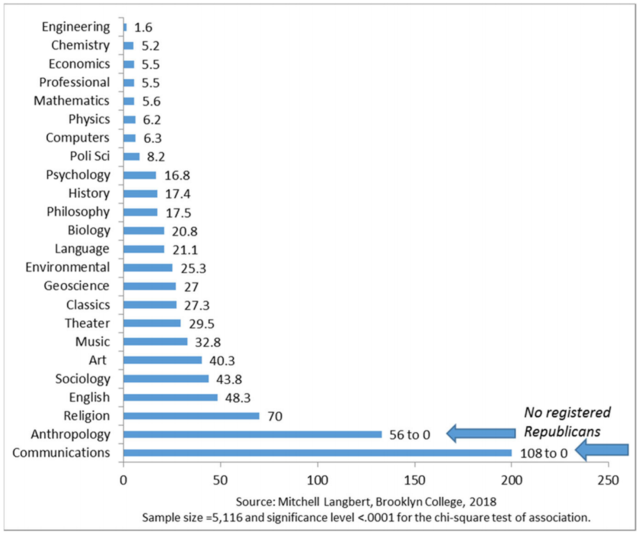
From Kaufmann's report, 28 percent of faculty in the social sciences and humanities identify as Far Left, and 38 percent identify as activists. As we have seen, some members of the Far Left endorse violence to achieve political ends. As the academy has shifted more and more Left over the decades, it has welcomed more and more extremists and activists. In this context, the rise of threats, bullying, and intimidation (albeit usually of the firing or de-platforming sort, rather than physical violence) against the "wrong" ideas, common among radicals and extremists, helps explain the rise of a culture of censorship.

This dynamic is captured by the Pyramid of Censoriousness. Informal social norms provide the base from which a culture of censorship emerges. The more censorship is accepted, the more it will be called for. People in positions of power (authorities) will then, either because they share the same censorious norms or because they are willing to cravenly cave to censoriousness to keep their positions, punish the targets of censorship campaigns (say, by firing or de-platforming them or, in the case of academic publishing, retracting articles).
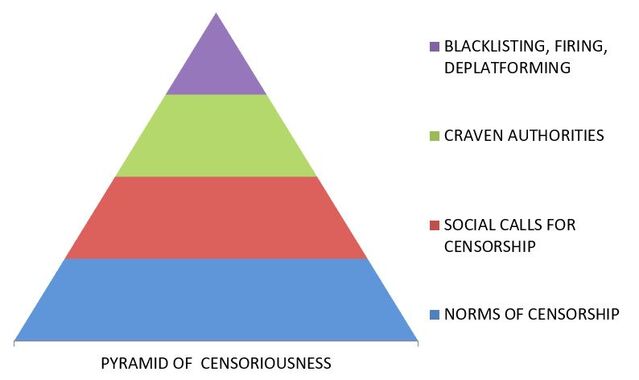
Has this actually affected actual faculty? Kaufmann's report addressed this as well. NAS in the figure stands for the National Association of Scholars, perhaps the last standing academic organization in the U.S. whose membership leans right politically. Kaufmann surveyed the NAS membership and found that substantial minorities reported being threatened with disciplinary actions for their beliefs or being bullied by colleagues, claims I consider credible based on my experiences described here.

When a culture of censorship is created, ideas can be purged in several ways:
- Directly, by authorities refusing to permit certain ideas into mainstream media or academic outlets, even when they meet conventional standards of journalistic or scholarly quality (or purging them when they do, e.g., by forced retractions).
- The person can be silenced by being de-platformed, fired, or intimidated.
- The ideas can be blocked from receiving a public hearing because the type of people who would promote those ideas learn not to even enter fields in which they would be subject to a hostile work environment.
The next figure from Kaufmann's report shows that academia has created what is experienced as a hostile work environment for graduate students who do not share the faculty's overwhelmingly leftist values. Who wants to work in a hostile environment?
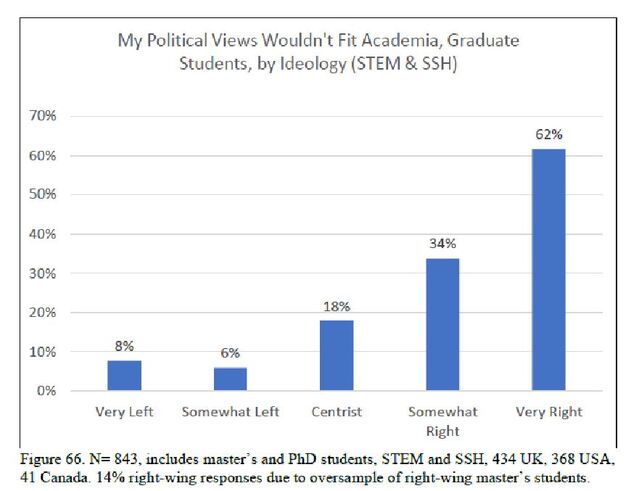
When young adults in college see faculty and graduate students advancing censorious norms of denunciation and ostracism rather than free expression, discussion, and debate, they are likely to learn three things:
- This is normal; it is how things work.
- If someone says or does something one finds offensive, one has the right to try to punish them.
- If one disagrees with the norm, or, worse, the mob, better to keep one's mouth shut than risk being denounced and ostracized one's self.

And then cadres of young people enter the "real" world, the world of work and family, where they may continue to take these censorious norms for granted. In the world of work, denunciation and self-interest sweetly converge. Not only can one gain social capital (within one's circles) for leading such campaigns, but when jobs are scarce, the more people one can get fired, the more positions will be open for one's self and one's friend and allies.
In this way, a Culture of Censoriousness is incentivized and will probably continue to build until something happens to disincentivize the cultural trend of punishing people for expressing certain ideas.




